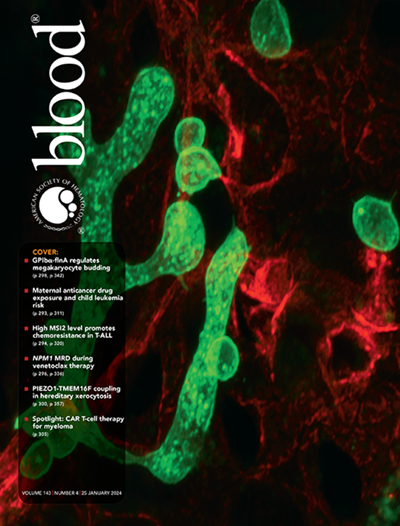The mitochondrial protease ClpP is a metabolic vulnerability and an immunogenic trigger against multiple myeloma.
IF 21
1区 医学
Q1 HEMATOLOGY
引用次数: 0
Abstract
Orchestrating key homeostatic functions, mitochondria likely entail cancer vulnerabilities. Moreover, due to their bacterial ancestry they can release potent immunogenic signals. Here we show that the mitochondrial protease ClpP is both a cell-intrinsic metabolic vulnerability and an actionable immunogenic trigger in multiple myeloma (MM). We found that ClpP mRNA is higher in bone marrow (BM)-purified malignant plasma cells (PC) than in normal or premalignant counterparts and that MM lines rank first for ClpP expression among human cancers. Moreover, we demonstrated that human MM cells are highly vulnerable to ClpP inhibition in vitro and in vivo. Surprisingly, MM cell dependence on ClpP was not accounted for by its acknowledged oxidative phosphorylation surveillance activity. Proteomic discovery of proteolytic targets, metabolomics, and metabolic tracing identified a critical control exerted by ClpP on ornithine aminotransferase abundance to sustain cytosolic biosynthesis of polyamines, essential to MM cells. Transcriptomics and targeted validation also revealed activation of a cyclic GMP-AMP synthase (cGAS)-dependent type-I interferon (IFN-I) response in ClpP-silenced MM cells, whose supernatants boosted dendritic cell activation and ability to stimulate IFNg production by T cells. In vivo, ClpP silencing re-shaped the BM immune environment in immunocompetent mice, significantly expanding IFNg-producing CD4+ and CD8+ T cells and CD4+ T memory cells, while containing exhausted CD4+ T cells and myeloid derived suppressor cells. Thus, ClpP is a novel addiction of MM cells, whose inhibition not only exerts cell-intrinsic toxicity, but also triggers otherwise indolent anti-tumoral immunity. Our findings yield a novel immunogenic chemotherapeutic framework of potential relevance against myeloma.线粒体蛋白酶ClpP是一种代谢脆弱性和免疫原性触发多发性骨髓瘤。
协调关键的稳态功能,线粒体可能导致癌症的脆弱性。此外,由于它们的细菌血统,它们可以释放有效的免疫原性信号。在这里,我们表明线粒体蛋白酶ClpP既是细胞内在的代谢易感性,也是多发性骨髓瘤(MM)中可操作的免疫原性触发因素。我们发现ClpP mRNA在骨髓(BM)纯化的恶性浆细胞(PC)中比在正常或癌前浆细胞中更高,MM系在人类癌症中ClpP表达排名第一。此外,我们证明了人MM细胞在体内和体外都极易受到ClpP的抑制。令人惊讶的是,MM细胞对ClpP的依赖性并没有被其公认的氧化磷酸化监视活性所解释。蛋白水解靶点的蛋白质组学发现,代谢组学和代谢追踪发现了ClpP对鸟氨酸转氨酶丰度的关键控制,以维持细胞内多胺的生物合成,这对MM细胞至关重要。转录组学和靶向验证还揭示了clpp沉默的MM细胞中环GMP-AMP合成酶(cGAS)依赖性i型干扰素(IFN-I)反应的激活,其上清液增强了树突状细胞的激活和刺激T细胞产生IFNg的能力。在体内,ClpP沉默重塑了免疫能力小鼠的BM免疫环境,显著增加ifng产生CD4+和CD8+ T细胞和CD4+ T记忆细胞,同时含有耗竭的CD4+ T细胞和髓源性抑制细胞。因此,ClpP是MM细胞的一种新型成瘾,其抑制不仅发挥细胞内在毒性,而且还引发了原本惰性的抗肿瘤免疫。我们的研究结果产生了一种新的免疫原性化疗框架,可能与骨髓瘤相关。
本文章由计算机程序翻译,如有差异,请以英文原文为准。
求助全文
约1分钟内获得全文
求助全文
来源期刊

Blood
医学-血液学
CiteScore
23.60
自引率
3.90%
发文量
955
审稿时长
1 months
期刊介绍:
Blood, the official journal of the American Society of Hematology, published online and in print, provides an international forum for the publication of original articles describing basic laboratory, translational, and clinical investigations in hematology. Primary research articles will be published under the following scientific categories: Clinical Trials and Observations; Gene Therapy; Hematopoiesis and Stem Cells; Immunobiology and Immunotherapy scope; Myeloid Neoplasia; Lymphoid Neoplasia; Phagocytes, Granulocytes and Myelopoiesis; Platelets and Thrombopoiesis; Red Cells, Iron and Erythropoiesis; Thrombosis and Hemostasis; Transfusion Medicine; Transplantation; and Vascular Biology. Papers can be listed under more than one category as appropriate.
 求助内容:
求助内容: 应助结果提醒方式:
应助结果提醒方式:


